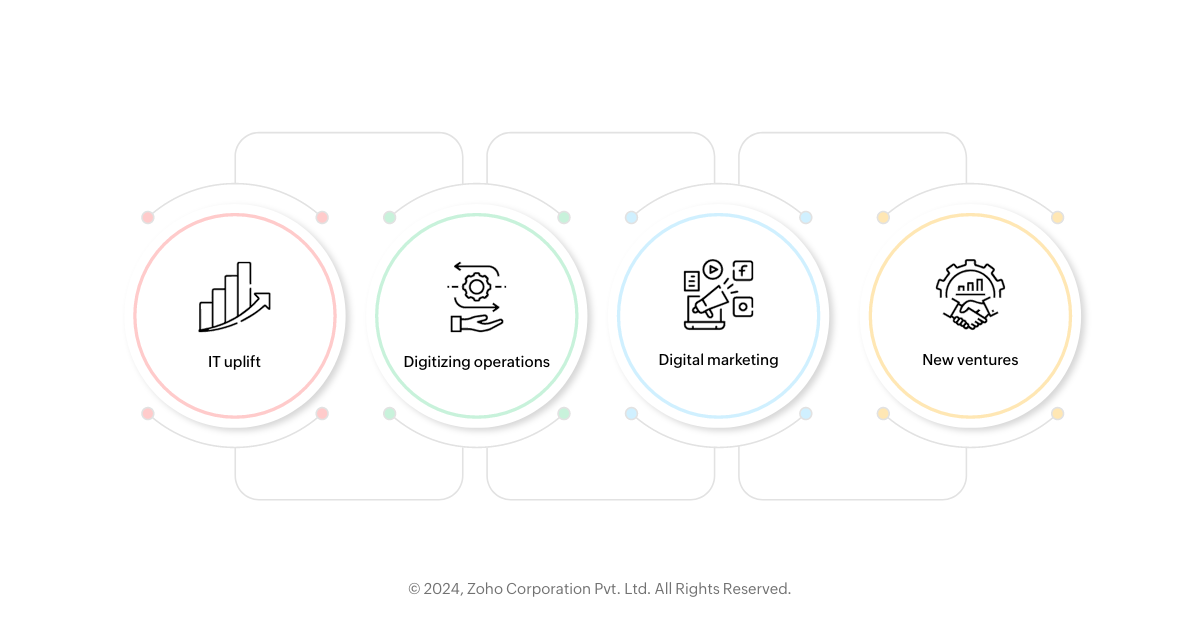- HOME
- Digital Transformation
- The 4 pillars of digital transformation: A framework for success
The 4 pillars of digital transformation: A framework for success
- Last Updated: March 28, 2024
- 1.1K Views
- 7 Min Read

Digital transformation has become a buzzword in the business world, but what does it really mean? For companies that have been in the market for years, making sudden core changes can be a challenge. Understanding the complex nature of the digital transformation journey is a challenge for many organizations, resulting in strategies that are not aligned and projects that do not succeed. To navigate the complexities of digital transformation, it is crucial to recognize the four key pillars that underpin successful transformation.
The digital transformation pillars

1. IT uplift
The first pillar of digital transformation is IT uplift. By upgrading their digital infrastructures, organizations gain access to up-to-date tools that enhance employee efficiency, reduce maintenance costs, and improve overall employee satisfaction. This pillar is usually overseen by the CIO or CTO, who concentrates on important metrics like increased availability of new technologies, decreased upkeep expenses, boosted employee contentment, and improved business results.
In today's digital age, investing in IT uplift is crucial for staying competitive. Research from IDC indicates that "Organizations which had begun an ERP cloud migration as part of a digital transformation initiative prior to the COVID-19 pandemic fared far better than organizations that didn't." Embracing advanced tools like AI can further enhance the benefits of IT uplift.
2. Digitization of operations
The second pillar of digital transformation is the digitization of operations. This means utilizing digital tools to enhance, streamline, and improve current processes. The goal is to streamline business growth and improve customer service. Digitizing operations can range from simple swaps of analog activities for digital ones to a complete redesigning of systems to meet the needs of today's customers.
The CFO or COO often spearheads this pillar as it requires a deep understanding of how the business works. KPIs for digitizing operations include time savings, cost savings, and improved customer service. By embracing digital tools such as AI, organizations can unlock transformational possibilities and create new sources of value.
3. Digital marketing
The third pillar of digital transformation is digital marketing. This pillar emphasises the utilization of digital tools to improve customer interactions, brand recognition, and sales. Digital marketing necessitates investing in accurate data collection, AI for comprehending customer actions, and a presence across various channels. Companies can use digital channels, AI, and predictive analytics to access prospects and customers, set up digital marketplaces, and identify critical customer behaviors.
4. New ventures
The fourth and final pillar of digital transformation is exploring new ventures. This pillar involves seizing new opportunities for growth and innovation. Organizations must develop the necessary digital capabilities to assess and shift to new sources of revenue. New opportunities could entail establishing fresh business models, innovating new products and services, or partnering with a vast network to generate new avenues for expansion.
CEOs or heads of sales typically lead this pillar as it requires significant investment, agility, and experimentation. Success is measured through unit economics measures and the ability to solve significant customer problems profitably. By embracing new ventures, organizations can unlock new sources of revenue and stay ahead of the competition.
Key challenges of the digital transformation strategy
Implementing digital transformation initiatives comes with its own set of challenges. One of the key challenges is resistance to change. Many workers may be hesitant to adopt new technologies or procedures due to concerns about losing their jobs or having to handle more tasks. To overcome this challenge, businesses must invest in change management strategies that involve clear communication, training, and support.
Another challenge is the complexity of integrating new technologies into existing systems and processes. Businesses may face technical challenges such as data integration, system incompatibility, and cybersecurity. To address these challenges, businesses must carefully plan and execute their digital transformation initiatives by involving IT experts and conducting thorough risk assessments.
Furthermore, businesses must consider the ethical implications of digital transformation, particularly regarding data privacy and security. With the increasing amount of customer data being collected and analyzed, businesses must ensure that they have robust data protection measures in place and that they comply with the relevant regulations.
Ways to successfully implement digital transformation
Customer experience transformation
By understanding the needs, preferences, and behaviors of customers, businesses can tailor their digital solutions to deliver personalized experiences that drive customer loyalty and satisfaction. In the digital age, customers have higher expectations than ever before. They expect seamless interactions, personalized recommendations, and fast response times. To meet these demands, businesses must invest in technologies that enable them to collect and analyze customer data. By leveraging data analytics, a business can gain valuable insights into customer behavior and preferences, allowing it to create targeted marketing campaigns and deliver personalized experiences.
Additionally, businesses can utilize AI and machine learning algorithms to automate customer service processes and provide real-time support. Chatbots, for example, can handle routine customer inquiries, freeing up employees to focus on more complex issues. This not only enhances customer satisfaction but also improves operational efficiency.
To successfully implement customer experience transformation, businesses must prioritize continuous improvement. This involves regularly analyzing customer feedback, monitoring KPIs, and making data-driven adjustments to improve the customer journey. By embracing a customer-centric approach, businesses can create a competitive advantage and drive growth in the digital age.
Operational agility transformation
With the abundance of data available, businesses can gain valuable insights into their strategies and make informed choices. This involves leveraging data analytics tools to drive operational efficiency and agility. By collecting and analyzing data from various sources, such as customer interactions, sales transactions, and supply chain operations, businesses can identify patterns, trends, and opportunities. This enables them to make data-driven decisions that optimize processes, reduce costs, and improve overall business performance.
For example, businesses can use predictive analytics to forecast demand and optimize inventory management. By analyzing historical sales data and external factors such as seasonality and market trends, businesses can accurately predict future demand and adjust inventory levels accordingly. This not only reduces costs associated with excess inventory but also ensures that products are readily available to meet customer demand.
Additionally, businesses can leverage data analytics to optimize their marketing strategies. By analyzing customer data, businesses can identify their target audience, understand its preferences, and tailor marketing campaigns to effectively reach and engage it. This allows businesses to allocate their marketing budgets more efficiently and achieve higher conversion rates.
To successfully implement operational agility transformation, businesses must invest in data analytics tools and develop the necessary skills and capabilities to analyze and interpret data. By embracing data-driven decision-making, businesses can drive operational efficiency, improve decision-making processes, and stay ahead of the competition.
Business model transformation
This involves embracing innovation, adopting new technologies, and being open to change. In today's fast-paced digital landscape, businesses must continuously evolve and adapt to stay relevant and competitive.
To achieve business model transformation, businesses must be willing to challenge traditional ways of doing things and explore new opportunities. This may involve adopting emerging technologies, such as cloud computing, the Internet of Things, and blockchain, to streamline operations, improve efficiency, and create new revenue streams.
For example, businesses can leverage cloud computing to reduce infrastructure costs, increase scalability, and improve collaboration. Cloud-based solutions enable businesses to access and share data in real time, regardless of the location, facilitating remote work and enhancing productivity.
Furthermore, businesses can explore new business models enabled by emerging technologies. For instance, the rise of the sharing economy has disrupted traditional industries such as transportation and accommodations. Companies like Uber and Airbnb have leveraged technology to create platforms that connect service providers with customers, bypassing traditional intermediaries. By embracing new business models, businesses can tap into new markets, reach a wider audience, and drive growth.
To successfully implement business model transformation, businesses must foster a culture of innovation and experimentation. This ensures that their members think independently, take measured risks, and embrace digital transformation. By embracing agility and adaptability, businesses can capitalize on new opportunities, drive innovation, and stay ahead of the competition.
Cultural transformation
By breaking down silos and encouraging cross-functional collaboration, businesses can leverage diverse perspectives and expertise to drive innovation and achieve better results. Additionally, businesses must foster a culture of continuous improvement. This involves encouraging employees to embrace a growth mindset, seek feedback, and continuously learn and develop new skills.
Digital transformation requires ongoing learning and adaptation as technologies and market dynamics evolve rapidly. By investing in employee training and digital transformation efforts, businesses can ensure that their workforce is equipped with the necessary skills and knowledge to navigate the digital landscape.
To successfully implement cultural transformation, businesses must lead by example and create a supportive environment that encourages collaboration, innovation, and continuous learning. By fostering a culture of collaboration and continuous improvement, businesses can create a competitive advantage and drive long-term success in the digital age.
Unlocking your digital potential
Digital transformation is a long but fruitful journey that requires patience, time, and resources. By recognizing and embracing the four key pillars of successful digital transformation, organizations can navigate the challenges and unlock the full potential of digital technologies. IT uplift, digitization of operations, digital marketing, and new ventures each play a vital role in driving digital transformation.
Companies undergoing digital transformation must allocate resources effectively, set clear goals and KPIs, and continuously adapt to the evolving digital landscape and business objectives. With a strategic approach and a focus on the four pillars, organizations can embrace digital transformation and position themselves for long-term digital transformation success.




